What’s killing Malibu Creek’s steelhead
April 6, 2010
Twice in recent summers, Malibu Creek’s fledging population of endangered steelhead have been decimated, leaving the experts baffled and saddened.
In 2006, hundreds of the fish turned yellow and died after a heat wave that was accompanied by a foul-smelling black layer of rotting algae and bacteria in the stream bed. The ooze earned a nickname: Malibu Muck.
By early 2008, the population of juvenile steelhead managed to edge toward 3,000 again, giving biologists hope that the fish were making a strong comeback.
But last year, the die-offs returned with a vengeance. Steelhead, as well as the hardy carp, crayfish and others, died en masse. The Malibu Muck was back, too. This time, the baby steelhead didn’t turn yellow but the population in the creek still plummeted from about 1,300 to just 200 young fish.
In the bad years, “everything was dying,” says conservation biologist Rosi Dagit. “And we really had absolutely no clue why.”
Last week, Dagit and other conservation biologists waded into the creek to look for answers, launching the most comprehensive water quality study ever undertaken in the crucial Santa Monica Mountains watershed.
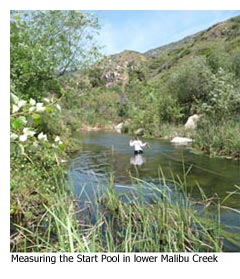 Standing waist deep in Malibu Creek, Steve Williams and Kevin Jonz carefully slid a high-tech measuring device called a sonde inside a plastic housing and dipped it into the algae-green water. They anchored the two-foot cylinder to the creek bed with a steel fence post and then fastened the contraption to a willow thicket with a stout metal chain.
Standing waist deep in Malibu Creek, Steve Williams and Kevin Jonz carefully slid a high-tech measuring device called a sonde inside a plastic housing and dipped it into the algae-green water. They anchored the two-foot cylinder to the creek bed with a steel fence post and then fastened the contraption to a willow thicket with a stout metal chain.
In all, five sondes were installed—four in Malibu Creek and one in nearby Topanga Creek. The devices will gather six vital measures of water quality every 30 minutes, around the clock, from April to October. The thousands of data points on water temperature, clarity, pH, algae levels, conductivity and oxygen levels will provide scientists with a full view of the changes in water quality over an entire season, from the high flows of spring to the slack low water of late summer and fall.
“The overarching question is what [water quality] factors are causing problems for the steelhead recovery,” says Dagit, a senior conservation biologist for the Resource Conservation District of the Santa Monica Mountains and the study’s lead scientist. “If you can find ways to give the fish a chance, then you can grow the population.”
Southern steelhead are sea-going rainbow trout that, like their salmon cousins, return to spawn in the creeks and rivers of their birth. The red-stripped, olive-and-silver fish, which can grow to 35 inches or more, has been in decline since the 1950s and became endangered more than a decade ago.
Thousands of tiny steelhead are born in creeks from San Luis Obispo to Mexico, but few survive to migrate to the Pacific. Today, the total population of adult fish that made it into the ocean off Southern California is estimated at only 500. (A northern subspecies, also endangered, ranges from Central California to Canada.)
If the southern steelhead are to stage a comeback, they’ll need to breed in the deep pools of streams like Malibu Creek, where the young must survive for a couple of years until they’re old enough to head to sea.
Dagit and others believe that the Malibu Muck is at least partially responsible for the carnage. They hope the new study will provide clues to why the muck can be so bad in some years and not in others. At its worst, it’s a carpet of black and white ooze a foot deep in places, coating the entire creek bed. Composed of rotting algae, bacteria and smelling like sulfur, the muck was “ubiquitous” at the time of the die-offs, Dagit says.
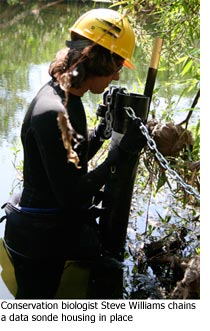 Whatever connects the muck to the fish kills, it’s not as simple as the presence of a simple toxin in the water. An earlier chemical analysis of a muck sample turned up nothing that would account for the deaths, says conservation biologist Sandra Albers.
Whatever connects the muck to the fish kills, it’s not as simple as the presence of a simple toxin in the water. An earlier chemical analysis of a muck sample turned up nothing that would account for the deaths, says conservation biologist Sandra Albers.
Today, steelhead can only travel two miles upstream, where a dam built in the 1920s blocks their path. So the scientists placed two sondes in the steelhead pools in the lowest parts of the creek. Two more will be placed in similar deep pools above the dam to see if conditions in the lower creek are significantly different. The sonde in Topanga Creek—a stream that also supports a small steelhead population—was placed there as a way to compare its healthier waters with those of Malibu Creek.
Albers and others will download the data every month via handheld devices that plug into the sondes, four of which are on loan from the Southern California Coastal Water Research Project and the other from the Las Virgenes Water District. Supervisor Zev Yaroslavsky’s office has committed $8,000 to help cover the project’s costs.
No one is expecting a simple fix. But the hope is that scientists can develop a new hypothesis by combining the data with ongoing studies of steelhead counts, algae populations and the proliferation of a tiny invasive pest called the New Zealand mud snail.
Still, the scientists believe they’ll find useful information that will someday allow steelhead to grow up in Malibu Creek once again in significant numbers.
“There are a couple of pieces of the puzzle that we don’t have a handle on,” says fish biologist Carl Demetropoulos, an environmental consultant who volunteers his time to help with the study and fondly remembers catching small steelhead with his dad in Malibu and Topanga in the mid-1960s. “Steelhead are really adaptable and the best hope is that they are already able to come back.”
Posted 4/6/10




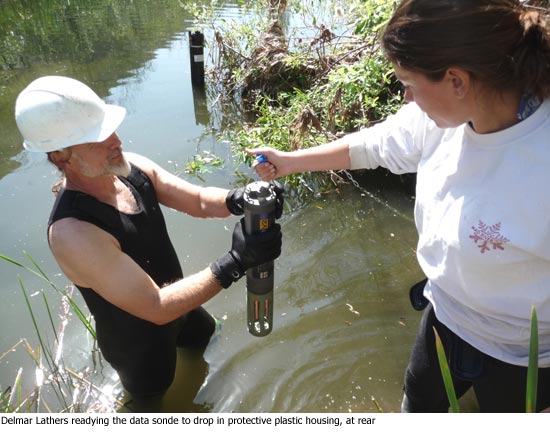
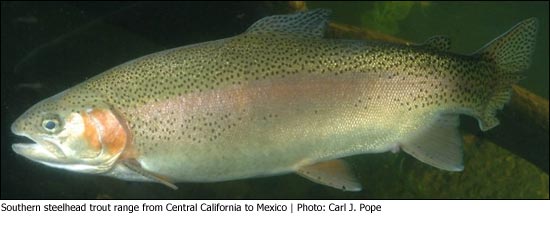
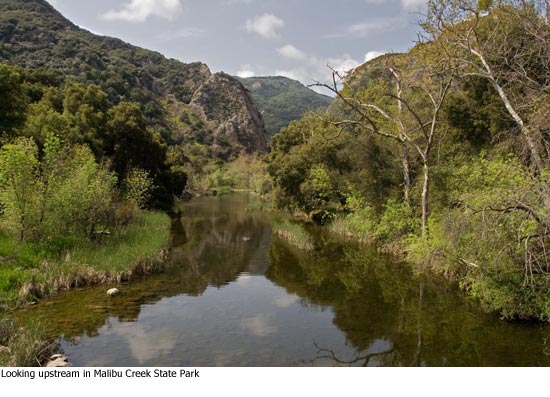








 405 bridge work causes a stink
405 bridge work causes a stink
